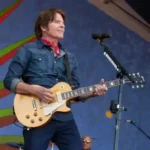
John Fogerty – Rock Legend, His Guitars and Gear
John Fogerty, best known as the lead guitarist and frontman of the iconic American rock band Creedence Clearwater Revival (CCR), has left an indelible mark on the music world.
Let’s dive into the life of John Fogerty, explore his impressive collection of guitars, and discuss the equipment that has helped shape his distinct sound.
Table of Contents
Early Life and Career
Born on May 28, 1945, in Berkeley, California, John Fogerty was raised in a musical household. His mother, Edith, was a classically trained pianist, and his father, Galen, played various instruments, including the guitar. Growing up, John’s love for music only intensified as he listened to artists like Little Richard, Elvis Presley, and Hank Williams.
In 1959, John and his brother Tom formed their first band, The Blue Velvets, which would later become the Golliwogs. However, it wasn’t until the late 1960s when the band evolved into Creedence Clearwater Revival that they began to achieve significant commercial success.
Creedence Clearwater Revival
As CCR’s frontman, John Fogerty’s distinct voice and guitar work became synonymous with the band’s sound. CCR churned out hit after hit, with classics such as “Proud Mary,” “Bad Moon Rising,” and “Fortunate Son” becoming staples of American rock music. The band’s unique blend of blues, rock, and country influences resonated with audiences around the world, and their success skyrocketed. Despite their incredible success, internal conflicts led to the band’s disbandment in 1972.
Solo Career
John Fogerty’s solo career took off in 1973 with the release of his debut album, “The Blue Ridge Rangers,” in which he played all the instruments himself. Over the years, he has released numerous successful albums, including “Centerfield” (1985) and “Revival” (2007). His solo work has allowed him to continue developing his distinctive sound and to collaborate with other notable musicians.
John Fogerty Guitars
Throughout his career, John Fogerty has been known for his preference for high-quality guitars:
- Rickenbacker 325: This was John’s first electric guitar, purchased in 1963. The Rickenbacker 325, with its unique shape and jangly tone, played a significant role in the early CCR sound.
- Gibson Les Paul Custom: This guitar became John’s primary instrument during the CCR days, responsible for the powerful, bluesy riffs heard on many of their hit songs. The Gibson Les Paul featured a black finish, which later inspired the nickname “Black Beauty.”
- Fender Telecaster: John’s love for the Telecaster is evident in both his CCR and solo work. He has used various models throughout his career, often favoring the ‘50s and ‘60s models for their vintage tone.
- Gibson ES-175: This hollow-body electric guitar has been used by John on occasion, particularly during his solo career, for a warmer, jazzier sound.
- Acoustic Guitars: John has used several acoustic guitars, including Martin D-28 and D-18 models, as well as Gibson J-200 and J-45 models. These guitars are responsible for the rich, resonant tones heard on many of his ballads and more introspective tracks.
- Custom “Baseball Bat” Guitar: This one-of-a-kind instrument was created by luthier Danny Ferrington for John’s 1985 album, “Centerfield.” The guitar features a baseball bat neck and a baseball diamond-shaped body, paying homage to John’s love for the sport.
Guitar Amplifiers and Effects
John Fogerty’s guitar tones are as important as the instruments he plays. Over the years, he has utilized various amplifiers to achieve his signature sound:
- Kustom Amplifiers: During the CCR era, John primarily used Kustom K-200 series amplifiers. These solid-state amps, known for their unique tuck-and-roll design, provided a clean and powerful platform for his guitar tones.
- Fender Tweed Deluxe: For his solo work, John has often turned to Fender Tweed Deluxe amplifiers, which deliver a warmer, more vintage sound. This classic tube amp is known for its dynamic response and natural overdrive.
- Mesa Boogie Mark Series: John has also used Mesa Boogie Mark series amplifiers in his solo career. These versatile amps provide a wide range of tones, from clean and sparkling to heavily overdriven.
- Effects: While John is not known for an extensive use of effects, he has been known to use a few pedals to enhance his sound. Some of his go-to effects include the Ibanez Tube Screamer, a classic overdrive pedal, and the MXR Phase 90, a popular phaser that adds a subtle, swirling texture to his guitar tone.
John Fogerty’s influence on rock music cannot be overstated. His unique blend of rootsy American music styles, powerful guitar playing, and emotive vocals have made him one of the most enduring and respected figures in the industry.


